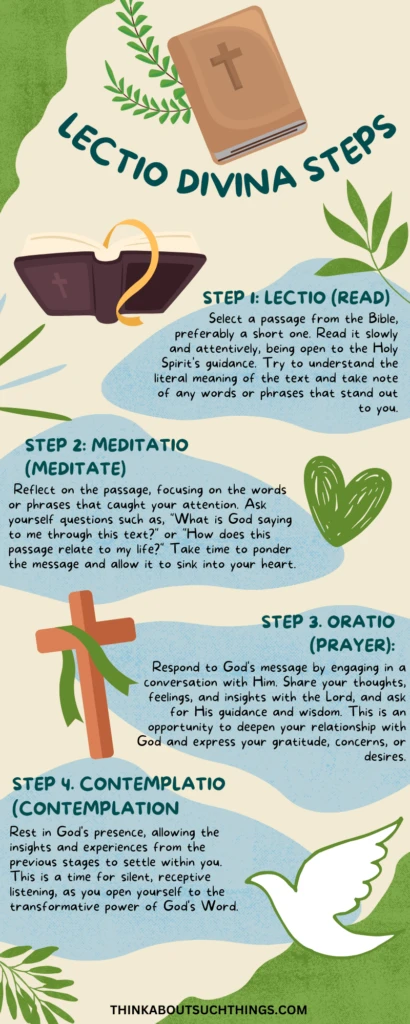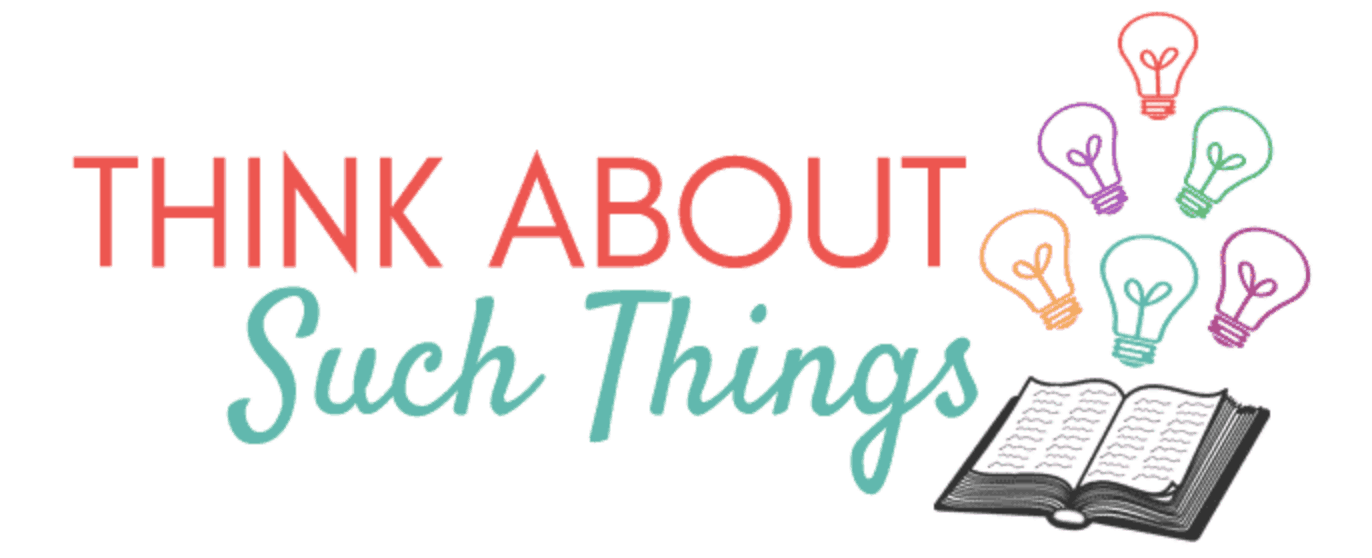In this article, we will learn easy lectio divina steps to guide you on how you can meditate on the Bible. So, grab your Bible, and let’s start meditating…
The Bible is full of references to meditating on God’s Word and the benefits that believers will receive when they actively do it.
Unfortunately, the meaning of meditation has been wholly corrupted by the emergence of Eastern religions that make it a religious practice and ritual that’s entirely humanistic.
When I was an intern way back in the day, I worked under a leader who taught Biblical meditation and learned how it was a biblical concept. Verses like Psalm 1:2, Joshua 1:8, and Psalm 19:14 refer to an action of actively meditating on God’s Word.
Avoiding this aspect of our spiritual lives because of wrong interpretations of the word “meditate” deprives us of so much growth in our walk with God.
One method of meditating on God’s Word is called Lectio Divina.
It’s a simple system that dates back to the late 5th or early 6th century when monks practiced it.
Yet the basis of it is still as effective today as it was then, and it’s a great way to study God’s Word and make it a part of your being.
So, what is Lectio Divina, and how can you practice it? Let’s find out!

What Is Lectio Divina?
Lectio Divina is a simple, step-by-step approach to meditating on the Bible. It means “divine reading” in Latin and is an ancient Christian practice.
It has been used by Christians for centuries as a means of deepening their relationship with God and growing in their spiritual journey.
The purpose of Lectio Divina is not only to gain knowledge of the Bible but also to encounter God’s presence and guidance through His Word.
The process is quite simple. Lectio Divina consists of four stages. We will go into each step in depth later, but here they are in a nutshell.
- Lectio (Reading): This is when you select your passage and begin to read it.
- Meditatio (Meditation): This is when you reflect on the passage, focusing on the words or phrases that caught your attention. You can ask yourself questions such as, “What is God saying to me through this text?” or “How does this passage relate to my life?”
- Oratio (Prayer): This is then we respond to God’s message by engaging in a conversation with Him. Share your thoughts, feelings, and insights with the Lord, and ask for His guidance and wisdom.
- Contemplatio (Contemplation): This is when you rest in God’s presence, allowing the insights and experiences from the previous steps to settle within you.
Lectio Divina can be beneficial for Christians as it encourages us to slow down, focus on God’s Word, and listen to the Holy Spirit’s guidance. It fosters a more profound, personal encounter with God through His Word and strengthens our faith.
The process of meditation helps you to understand the portion of scripture you’re studying and ingrain it in your mind to help with your spiritual growth by showing you how it applies to you personally.
It’s all part of God’s instruction to renew your mind.
Before we get into the practical steps, let’s consider a few words of warning.
It’s Not A Ritual
It’s so easy for believers to fall into some kind of ritual or formula when it comes to our spiritual walk.
We might begin a habit of getting up early in the morning to pray, and it soon becomes a religious tradition to the point where we feel we failed God when we miss one morning because the alarm didn’t go off.
That should never be what Lectio Divina becomes. It’s not a way to please or appease God, as that only happens through faith in Jesus Christ.
However, Lectio Divina can help us form a clearer understanding of God and His Word and experience His presence, which will stir our faith. It helps us to focus on God and draw closer to Him—nothing more and nothing less.
An easier way to put it is that it helps us develop our relationship with God.
Don’t Take It Out Of Context
Lectio Divina is a system that easily lends itself toward meditating only on a small portion of scripture, like a few verses, at a time. This is fine, but when you choose a piece of scripture to meditate on, check its context first.
That way, you can be sure to meditate on it within the context that God meant it.
For example, Matthew 4:9 says, “And he said to him, ‘All these I will give you, if you fall down and worship me.’”
That verse in itself sounds like an excellent scripture to meditate on! However, when you view it in the context, you will see in verse 8 that this is the devil speaking to Jesus when he was tempting Him.
It’s not a promise from God to claim for yourself, but the devil trying to get Jesus to bow to him. Many have fallen for the trap by sharing that verse on social media and typing “amen.”
Don’t take a scripture without context. So many of the problems in the modern church occur because preachers take verses out of context, distorting God’s intentions and deceiving His people in the process.
If you are unsure about a verse, read the whole chapter for context. This will help give you a much better scope of what the verse means, who said it, and so on.
Now, let’s get to studying the method of Lectio Divina.
Lectio Divina Steps

Preparation
Before we start with the actual steps, you need to do some preparation. This involves two things:
- Choose a scripture to meditate on. This can be anything; something you don’t understand, something you know you’re struggling with, or even just a scripture you want to make a more active part of your spiritual life.
If you need some help, then you can check out my Topical Bible Verses page or look at some Biblical affirmations using the scriptures associated with the affirmation. - Pray and ask the Holy Spirit to reveal the truth of this scripture to you. Ask Him to help you understand what He is trying to say in it and to help you focus on it.
I do have additional advice, but it’s 100% optional.
- Use a paper Bible and not your phone or computer. It’s too easy to get distracted on digital devices, and meditation can be tough when starting out. Using a regular Bible helps us to focus.
- Go somewhere quiet. Trying to meditate with someone blasting music or TV can be tough. Yes, it can be done, but if you can find a quiet section of the house or somewhere outside, I say go for that.
- Having worship music in the background can be a great help with meditation, but I would recommend worship songs that are softer and more mellow to help you stay focused on the Bible verse and not the lyrics of the song.
Step 1: Lectio (Read)
This step involves reading the portion of scripture out loud. Take note of the following:
- Read it out loud if you can. This is important since it helps if you can hear it. Involving more of your senses helps with understanding and retaining information. And in my own experience, I notice a spiritual difference when I speak a verse out, even if it’s in a quite voice.
- Read it slowly. Don’t rush through it. Take your time; read it as if you’re reading it to a child who has to hear every word clearly.
- Identify words that jump out at you and catch your attention. Linger on those words a moment longer and repeat them if necessary. Try to understand why God used those specific words in that context.
If you are reading, a portion of the passage and God’s presence shows up. Make sure to stop and reread that portion again. Read it slowly and let it sink in. (this connects with step 2) - Feel free to highlight these words as you proceed; it will help you to focus on them and remember them for the next steps.
Step 2: Meditatio (Meditate)
This step involves reading the same portion of scripture a second time, preferably out loud again. Identify the feelings and thoughts that arise as you read, focusing on what you want to talk to God about.
You will often have questions that arise during this step, or you may have strong feelings about something that feels controversial or that is challenging to you personally.
This is not the time to answer those questions or solve those issues. Your goal, for now, is to simply identify and acknowledge the questions and feelings.
Step 3: Oratio (Pray)
Read your portion of scripture a third or even a fourth time (there are no hard rules). You can read it out loud again, but this time it doesn’t matter too much if you don’t.
However, you should still read it slowly and emphasize the portions that jump out at you or when you feel God’s presence!
What makes this step different is that you now enter into a conversation with God. The monologue (God speaking to you through His Word) should become a dialogue. Ask God the questions that arise as you read through.
Tell Him about the thoughts, feelings, and challenges you notice. Share all of this with God.
This is often the step when God starts to reveal the answers to you, but don’t be discouraged if He doesn’t do so immediately; He will answer your questions at the right time and seaspm.
Just make sure you go through it slowly enough to give Him an opportunity to do so.
Now, what if you don’t have any questions to ask? This is when I would then take the passage and give God praise, adoration, and thanks for what it says.
Step 4: Contemplatio (Contemplate)
Read through the scripture a fourth or fifth (and final) time. Then rest in God’s presence, allowing the insights and experiences from the previous steps to settle within you. This is a time for silent, receptive listening, as you open yourself to the transformative power of God’s Word.
Later on you can think about what you’ve already learned from it, and thank God for that.
Consider any actions that God is calling you to take and thank Him for trusting you with that. This should be the conclusion of your prayer and your time of meditation.

After The Meditation
Many believers find it helpful to use the time immediately after the meditation to take some notes. I have found this helpful as God will sometimes speak to you and reveal things. Even on occasions you might even have a vision.
Get a prayer journal and write down what God showed you and anything else that you noticed that you might not yet have an answer or solution for.
Also, make a note of any actions that you know you must take following your meditation, and perhaps write down how and when you are going to do that. This will help you set an action plan to get it into motion.
Lectio Divina is often criticized as being a dangerous practice by some Bible scholars, and with good reason. If you make it a religious tradition or take scriptures out of context, you can easily be deceived, but that’s true of any form of Bible study.
However, when you use it correctly, Lectio Divina can help you grow spiritually and add new vitality to your Bible study and prayer time.
Well, I hope you have enjoyed this article and that you have found it help to learn lectio divina steps and are able to try it out during your devitional time.

Melissa is a passionate minister, speaker and an ongoing learner of the Bible. She has been involved in church and vocational ministry for over 18 years. And is the founder of Think About Such Things. She has the heart to equip the saints by helping them get into the Word of God and fall more in love with Jesus. She also enjoys family, cooking, and reading.
She has spoken in churches in California, Oregon, Texas, and Mexico and has been featured in Guidepost Magazine and All Recipes Magazine. Read More…
